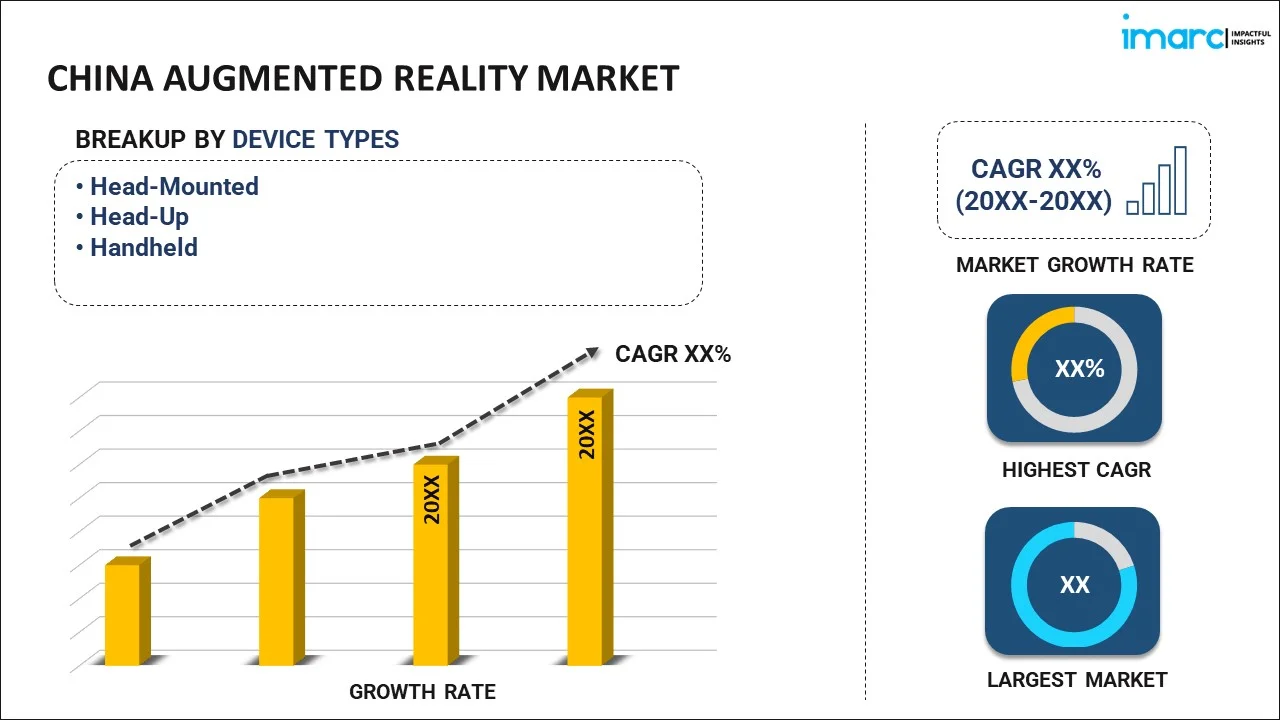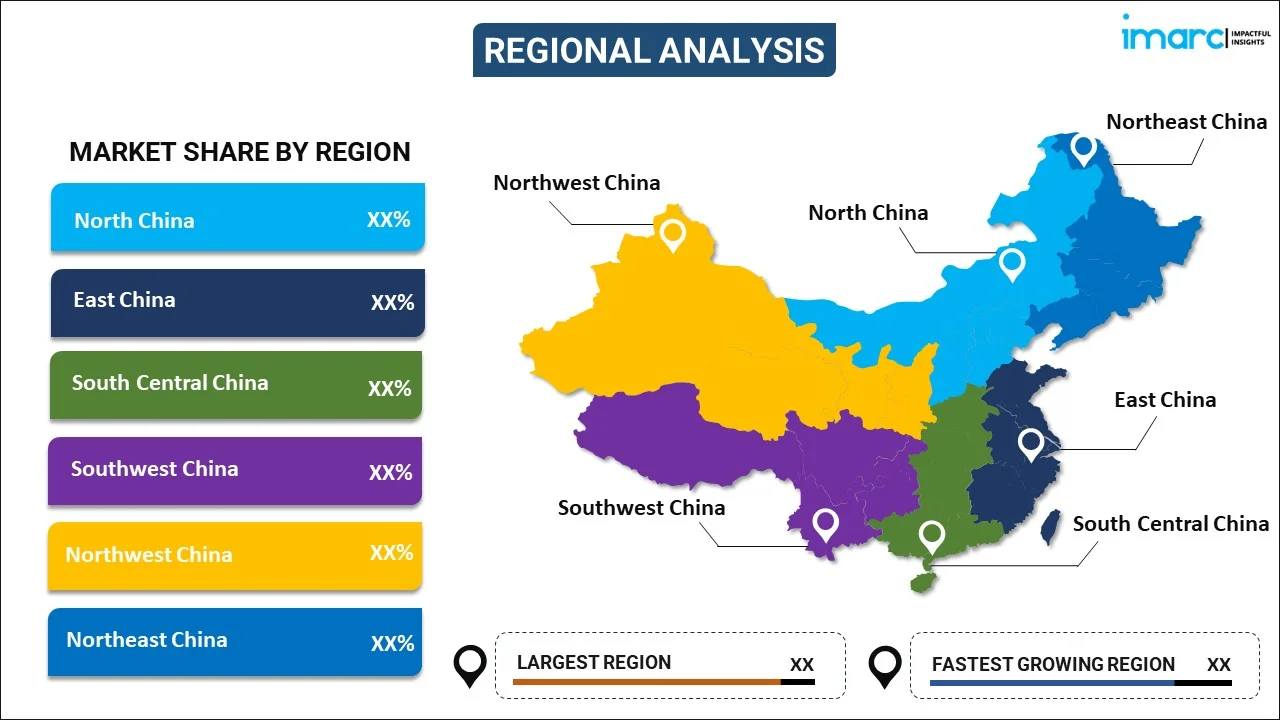
China Augmented Reality Market Report by Device Type (Head-Mounted, Head-Up, Handheld), Technology (Monitor Based Technology, Near Eye Based Technology), Component (Hardware, Software), Application (Gaming, Media, Automotive, Retail, Healthcare, Education, Manufacturing, Real Estate, Defense & Aerospace, Law Enforcement, and Others), and Region 2025-2033
China Augmented Reality Market Overview:
The China augmented reality market size reached USD 13,788.9 Million in 2024. Looking forward, IMARC Group expects the market to reach USD 80,155.4 Million by 2033, exhibiting a growth rate (CAGR) of 21.6% during 2025-2033. The retail sector's use of virtual try-ons, immersive educational tools, innovative augmenting reality (AR) gaming, advancements in AR hardware, escalating healthcare applications, robust manufacturing capabilities, supportive government policies, the advent of fifth generation (5G), automotive industry integration, and AR-enhanced tourism experiences are some of the factors propelling the market growth.
|
Report Attribute
|
Key Statistics
|
|---|---|
|
Base Year
|
2024
|
|
Forecast Years
|
2025-2033
|
|
Historical Years
|
2019-2024
|
|
Market Size in 2024
|
USD 13,788.9 Million |
|
Market Forecast in 2033
|
USD 80,155.4 Million |
| Market Growth Rate 2025-2033 | 21.6% |
China Augmented Reality Market Trends:
Increasing Adoption of AR in Retail
Companies in China are using AR to drive sales for the retail industry as this strategic technology adoption is transforming the way consumers interact with products and make purchasing decisions. Through AR technology, consumers can virtually try on clothing, accessories, and even makeup, facilitating a virtual "try before you buy" experience. Moreover, retailers are utilizing AR beyond mere advertisements by providing interactive product displays and virtual showrooms with up-close visualizations of products. This kind of immersive shopping experience makes tech-savvy consumers interested but also creates the higher level of engagement and conversion. In addition to this, AR in retail allows for decreasing return rates by giving the users accurate product visuals which automatically leads to wise buying decisions.
Leveraging AR for Immersive Learning in Education
AR is redefining the limits to which students can learn by breaking down complicated topics and making them more comprehensible. For example, a recent IPSOS survey combining augmented reality (AR), virtual reality (VR) and mixed reality (MR) or extended reality (XR) found that 78% of Chinese are positive about the technology. This is 28% higher than the global average. In China, AR has been added to school and university curricula in a move toward more interactive educational experiences. Using educational AR apps, students can access three dimensional (3D) models of historical objects, scientific simulations and a range of dynamic biological processes to make learning interactive. Moreover, AR contributes to a more modern way of studying remotely with virtual classrooms–students can interact with augmented objects and simulations in order to conduct learning practices despite spatial limitations.
Significant Impact of AR in the Gaming Industry
The gaming industry in China is one of the most dynamic sectors driving the adoption of AR. These games encourage outdoor activities and social interaction, making them highly popular among young gamers. The success of AR games has spurred significant investment in AR gaming development, leading to the creation of more sophisticated and engaging AR gaming content. Moreover, Chinese tech giants are investing heavily in AR technology to enhance their gaming platforms and create unique gaming experiences that stand out in the competitive market. The ability of AR to create captivating and interactive environments has transformed gaming from a solitary activity to a social and engaging experience. This has not only increased user engagement but also expanded the market for AR games, contributing to the overall growth of the AR industry in China.
China Augmented Reality Market News:
- In 2024: Alibaba Cloud's AI capabilities will be integrated to develop new applications and services for LVMH's global consumers. LVMH Group and Alibaba Group announced an extended partnership to enhance the luxury shopping experience in China. The collaboration will leverage Alibaba’s advanced cloud technologies and AI-driven innovations in retail, both online and through Tmall. It will enable LVMH to enhance its omnichannel presence, data capabilities, and technological footprint in China.
- In 2024: Baidu’s new DuSee platform allows people to make use of augmented reality within the Chinese internet giant’s apps, such as Mobile Baidu search, and takes advertising to the next level. In a demo of the technology, when a user of the Mobile Baidu app points their smartphone at a map of Shanghai, a virtual 3D.
China Augmented Reality Market Segmentation:
IMARC Group provides an analysis of the key trends in each segment of the market, along with forecasts at the country level for 2025-2033. Our report has categorized the market based on device type, technology, component, and application.
Device Type Insights:

- Head-Mounted
- Head-Up
- Handheld
The report has provided a detailed breakup and analysis of the market based on the device type. This includes head-mounted, head-up, and handheld.
Technology Insights:
- Monitor Based Technology
- Near Eye Based Technology
A detailed breakup and analysis of the market based on the technology have also been provided in the report. This includes monitor based technology and near eye based technology.
Component Insights:
- Hardware
- Software
The report has provided a detailed breakup and analysis of the market based on the component. This includes hardware and software.
Application Insights:
- Gaming
- Media
- Automotive
- Retail
- Healthcare
- Education
- Manufacturing
- Real Estate
- Defense & Aerospace
- Law Enforcement
- Others
A detailed breakup and analysis of the market based on the application have also been provided in the report. This includes gaming, media, automotive, retail, healthcare, education, manufacturing, real estate, defense & aerospace, law enforcement, and others.
Region Insights:

- North China
- East China
- South Central China
- Southwest China
- Northwest China
- Northeast China
The report has also provided a comprehensive analysis of all the major regional markets, which include North China, East China, South Central China, Southwest China, Northwest China, and Northeast China.
Competitive Landscape:
The market research report has also provided a comprehensive analysis of the competitive landscape in the market. Competitive analysis such as market structure, key player positioning, top winning strategies, competitive dashboard, and company evaluation quadrant has been covered in the report. Also, detailed profiles of all major companies have been provided.
China Augmented Reality Market Report Coverage:
| Report Features | Details |
|---|---|
| Base Year of the Analysis | 2024 |
| Historical Period | 2019-2024 |
| Forecast Period | 2025-2033 |
| Units | Million USD |
| Scope of the Report | Exploration of Historical Trends and Market Outlook, Industry Catalysts and Challenges, Segment-Wise Historical and Future Market Assessment:
|
| Device Types Covered | Head-Mounted, Head-Up, Handheld |
| Technologies Covered | Monitor Based Technology, Near Eye Based Technology |
| Components Covered | Hardware, Software |
| Applications Covered | Gaming, Media, Automotive, Retail, Healthcare, Education, Manufacturing, Real Estate, Defense & Aerospace, Law Enforcement, Others |
| Regions Covered | North China, East China, South Central China, Southwest China, Northwest China, Northeast China |
| Customization Scope | 10% Free Customization |
| Post-Sale Analyst Support | 10-12 Weeks |
| Delivery Format | PDF and Excel through Email (We can also provide the editable version of the report in PPT/Word format on special request) |
Key Questions Answered in This Report:
- How has the China augmented reality market performed so far and how will it perform in the coming years?
- What has been the impact of COVID-19 on the China augmented reality market?
- What is the breakup of the China augmented reality market on the basis of device type?
- What is the breakup of the China augmented reality market on the basis of technology?
- What is the breakup of the China augmented reality market on the basis of component?
- What is the breakup of the China augmented reality market on the basis of application?
- What are the various stages in the value chain of the China augmented reality market?
- What are the key driving factors and challenges in the China augmented reality?
- What is the structure of the China augmented reality market and who are the key players?
- What is the degree of competition in the China augmented reality market?
Key Benefits for Stakeholders:
- IMARC’s Application report offers a comprehensive quantitative analysis of various market segments, historical and current market trends, market forecasts, and dynamics of the China augmented reality market from 2019-2033.
- The research report provides the latest information on the market drivers, challenges, and opportunities in the China augmented reality market.
- Porter's five forces analysis assist stakeholders in assessing the impact of new entrants, competitive rivalry, supplier power, buyer power, and the threat of substitution. It helps stakeholders to analyze the level of competition within the China augmented reality application and its attractiveness.
- Competitive landscape allows stakeholders to understand their competitive environment and provides an insight into the current positions of key players in the market.
Need more help?
- Speak to our experienced analysts for insights on the current market scenarios.
- Include additional segments and countries to customize the report as per your requirement.
- Gain an unparalleled competitive advantage in your domain by understanding how to utilize the report and positively impacting your operations and revenue.
- For further assistance, please connect with our analysts.
 Request Customization
Request Customization
 Speak to an Analyst
Speak to an Analyst
 Request Brochure
Request Brochure
 Inquire Before Buying
Inquire Before Buying




.webp)




.webp)












